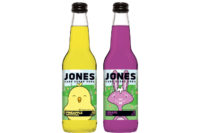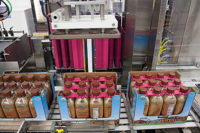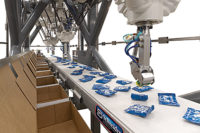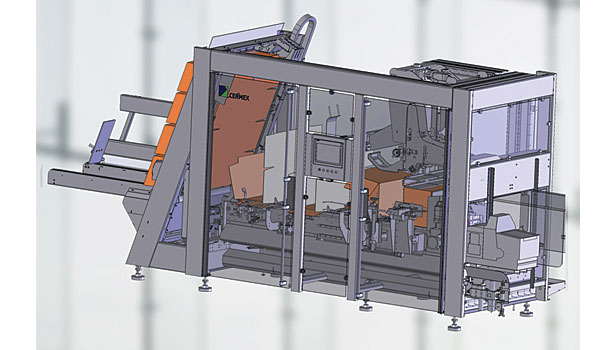Case packers adjust to handle lightweight, flexible packages
Small container sizes introduce pack configuration puzzles




When parents are teaching their children how to handle breakable objects, they often remind them to use extra care and handle it gently with two hands. The case packers segment of a beverage line also is learning to handle newer, more breakable packages with care in order to ensure that lightweight and flexible packages are gently packed and shipped to stores in one piece.
For example, when Kansas City, Mo.-based Boulevard Brewing Co., now a part of Puurs, Belgium-based Duvel Moortgat, wanted to add a high-speed packaging line to its expanded facility in 2008 in order to keep up with production demand, it found that it needed a new solution to handle lightweight bottles, according to the case study “Packaging Line Improvements Keep Craft Brewer Focused on the Future,” by Standard-Knapp Inc., Portland, Conn. The industry trend of lightweighting, which was prevalent even back then, created lightweight glass bottles that save money and materials but are weaker and less able to stand up to rugged drop-packing, Boulevard Brewing Director of Engineering Mike Utz explained in the case study.
The company originally invested in a rebuilt and converted 939S Versatron intermittent-motion case packer from Standard-Knapp but soon found that the high-speed machine, which met the company’s speed requirements, also came with a high bottle breakage rate during packaging, according to the case study. To customize the machine to accommodate gentle case handling, Standard-Knapp engineers retrofitted the case packer with a Pic-N-Place module, which picks product from the infeed conveyor and gently places it into the bottom of the empty case.
“The two-axis, servo-controlled Pic-N-Place acts just like a person’s arms, offering smooth operation,” Standard-Knapp stated in the case study. “It gave Boulevard soft container handling and is engineered to grab product in the optimum, most-secure position or spot, … virtually eliminat[ing] packaging breakage.”
As a result of the modification, Boulevard Brewing Co. reported nearly zero bottle breakage at the packaging step. In addition, it helped the company achieve production records, increasing throughput by about 10 percent, as breakage used to cause frequent shutdowns to clean out the packer and restart the line. “We sent more finished cases down to our palletizer than ever before,” Boulevard’s Utz said in the case study. “The machine is not faster, but the efficiency is much greater, and there is less down time, less disruption to the flow of beer, and more packages.”
Similar gentle-handling considerations should be implemented when handling lightweight plastic bottles. Because of the effects lightweighting has had on plastic bottles, packaging equipment suppliers are revamping their product offerings to meet these changing needs. “The use of thinner bottle materials affects the ability of older machines to effectively run them,” says Jamie Quinn, communications and training manager for Douglas Machine Inc., Alexandria, Minn. “Also, as speeds increase and as bottles use thinner walls to save materials, older solutions are more likely to damage or break bottles than horizontal wrap-around case-packing machines. … Douglas has existing technologies and several new innovations specifically developed around the gentle handling and proper surge control for bottles.”
Some of these portfolio updates include its SmartTrak II mass-flow infeed, which eliminates soft bottle bridging and includes modulated speed control programming for surge pressure relief at the choke point, as well as other surge-control and product-grouping systems that can work together to provide the flexibility and product control needed to handle lightweight packages, he adds.
Similarly, Standard-Knapp offers soft-catch and no-drop technologies to prevent damage to lightweight packages. Its soft-catch technology is designed to reduce the impact on the product during its drop, and the company’s 939 and 949 Pic-N-Place case packers completely place the product directly into the case without dropping the product at all, thus reducing the chance of damage, says Mario Mazzotta, marketing manager for Standard-Knapp.
Getting flexible
Flexible packages, like pouches, add another curveball to the packaging line’s handling work. “Flexible packaging is a bigger challenge … because pouches behave differently,” says Barry Rinaldi, director of business development service at Schneider Packaging Equipment Co. Inc., Brewerton, N.Y. “They lack uniformity due to their soft sides and have a tendency to tip randomly along a conveyor.”
As in the case of other lightweight packages, packaging machinery needs to be appropriately designed to handle flexible packages, says Rick Gessler, director of marketing and strategic accounts for Delkor Systems Inc., St. Paul, Minn. “As you would imagine, a case packer that we designed to run a rigid container is likely not going to cope well with a flexible pouch,” he explains. “Further, many of the design aspects of the entire line, such as accumulation or buffering, need to be addressed. Pouches, whether paper- or foil-based, do not accumulate, or collate, like rigid bottles. In places where a traditional case packer may have relied on picking up groups of backlogged products, the flexible packer will have to segregate pouches in pockets or pick individual pouches for placement in cases.”
Multiple equipment options are available to help beverage and packaging companies handle flexible packages. For conveying, Ed Mets, sales director for BluePrint Automation Inc., Colonial Heights, Va., suggests using vacuum belts to keep light products under control. Schneider Packaging Equipment recommends vision systems to ensure that the packages are properly oriented. “Vision-guided packaging is an important new component to convenient case packing because of the need to uniformly orient odd shapes, such as pouches, that don’t line up easily in a box,” Rinaldi says. Vision-guided robotic solutions can handle an almost endless variety of orientations and pack patterns.”
Last fall, Delkor Systems introduced a new line of case packers for flexible pouches. Its HSP-400 high-speed and MSP-200 mid-speed case packers were specifically designed to pack stand-up pouches into shelf-ready cases and other secondary packaging, the company says. The HSP-400 includes a patent-pending conveyor that aligns pouches for timed delivery to robotic pickup. Gantry robots then load 300 pouches a minute into cases, which are then glued and sealed for delivery. The MSP-200 utilizes two robots working in concert to orient and load packages into multiple case formats at speeds as fast as 150 pouches a minute.
Schneider Packaging Equipment also offers end-of-arm tools, which are sensitive to both the primary package being handled and its secondary packaging, Rinaldi says. From a cost perspective, end-of-arm tooling can be 3-D printed, making it more flexible in terms of customization, more lightweight and more cost effective than having a new tool head machined, he says. It also allows for tight nesting and flex-pack patterns that make the most efficient use of space and packaging materials, he adds.
The shape game
Case packers and wrappers also face challenges handling and packing containers of different sizes and shapes. With more Americans on the go, consumers are seeking smaller-sized beverage containers that they can consume outside of the home, at work or while commuting, says Bryan Sinicrope, vice president of sales and marketing at A-B-C Packaging Machine Corp., Tarpon Springs, Fla. In line with this, packaging design teams are creating small and uniquely shaped containers that meet these needs, explains Staci Cretu, marketing and communications manager for Westfalia Technologies Inc.
To handle these types of packages, the York, Pa.-based company released its Round Bottle Caser, which is capable of loading a broad range of bottle sizes, including round bottles and traditional gallon- and half-gallon plastic jugs, Cretu says.
In addition, packing some of these smaller and uniquely shaped containers can create a puzzle for case-packing equipment. “There is a lot of wasted space when smaller-sized bottles are packed into these cases with a straight, uniform pattern,” Cretu explains. To better make use of packing space, Westfalia’s Round Bottle Caser can create offset patterns to optimize the number of bottles that can fit in a plastic case, she says.
Douglas Machine’s Quinn notes that he’s seeing more customers considering offset pack patterns in general because of the arrangement’s multiple advantages. “With the offset film packages, our beverage customers gain pack integrity and shrink strength,” he notes. “Offset packages [also] can eliminate the need for corrugate trays and pads, which reduces package costs and reduces material waste.”
In line with the reduction of corrugated cardboard support as well as LDPE film, Roger Arbour, key market director for water, carbonated soft drinks and juices at Gebo Cermex, says the industry also is trending toward thinner but high-quality shrink-films to wrap cases of PET and high-density polyethylene bottles, cans and cartons. The Reichstett, France-based company’s Versafilm range of shrink-wrappers uses recycled or biodegradable low-density polyethylene film that is 20-80 microns thick.
The saved materials also can help beverage brands meet retailers’ packaging sustainability requirements, Standard-Knapp’s Mazzotta points out. “Many retailers are following a sustainability scorecard and are driven to reduce the amount of corrugate being used.”
Working ahead
As packaging experts continue to focus on ways to make primary and secondary packages more sustainable, case packing and wrapping equipment suppliers need to create and supply machines that will help beverage-makers keep up with evolving packaging demands while offering overall affordability, Gebo Cermex’s Arbour says. “[Beverage manufacturers] look at a low total cost of ownership — cost of machine, parts, services, energy, raw materials, etc. — but at the same time require the equipment to be easily upgraded with newer options.”
Gebo Cermex’s Dijon, France-based packaging business unit designed its WB45 wrap-around case packer with flexibility in mind, Arbour says. The system can handle a variety of secondary packaging items, including complete wrap-around blanks, trays and shelf-ready packaging at increased capacity. In addition, it features a simplified mechanical design that allows quick, easy changeovers between packaging formats, the company says.
Delkor’s Gessler agrees that flexibility is a key feature in packaging equipment in order to keep customers up to speed with market demands. “It is sure to be several years before the dust settles on these new package formats, and until that happens, if it ever happens, being able to cope with change is key.”
Looking for a reprint of this article?
From high-res PDFs to custom plaques, order your copy today!









